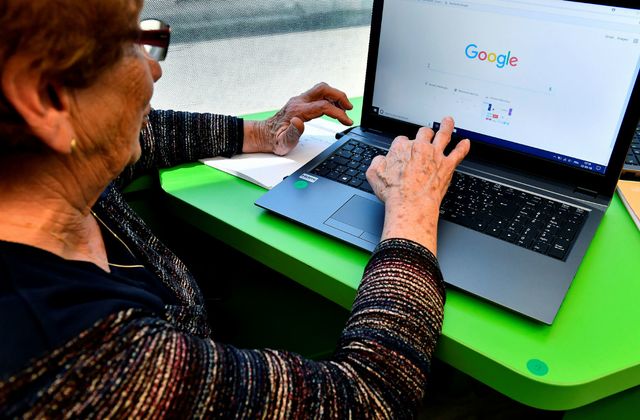Older Americans are disproportionately more likely to share fake news on Facebook, according to a new analysis by researchers at New York and Princeton Universities. Older users shared more fake news than younger ones regardless of education, sex, race, income, or how many links they shared. In fact, age predicted their behavior better than any other characteristic — including party affiliation.
The role of fake news in influencing voter behavior has been debated continuously since Donald Trump’s surprising victory over Hillary Clinton in 2016. At least one study has found that pro-Trump fake news likely persuaded some people to vote for him over Clinton, influencing the election’s outcome. Another study found that relatively few people clicked on fake news links — but that their headlines likely traveled much further via the News Feed, making it difficult to quantify their true reach. The finding that older people are more likely to share fake news could help social media users and platforms design more effective interventions to stop them from being misled.
Today’s study, published in Science Advances, examined user behavior in the months before and after the 2016 US presidential election. In early 2016, the academics started working with research firm YouGov to assemble a panel of 3,500 people, which included both Facebook users and non-users. On November 16th, just after the election, they asked Facebook users on the panel to install an application that allowed them to share data including public profile fields, religious and political views, posts to their own timelines, and the pages that they followed. Users could opt in or out of sharing individual categories of data, and researchers did not have access to the News Feeds or data about their friends.
About 49 percent of study participants who used Facebook agreed to share their profile data. Researchers then checked links posted to their timelines against a list of web domains that have historically shared fake news, as compiled by BuzzFeed reporter Craig Silverman. Later, they checked the links against four other lists of fake news stories and domains to see whether the results would be consistent.
Across all age categories, sharing fake news was a relatively rare category. Only 8.5 percent of users in the study shared at least one link from a fake news site. Users who identified as conservative were more likely than users who identified as liberal to share fake news: 18 percent of Republicans shared links to fake news sites, compared to less than 4 percent of Democrats. The researchers attributed this finding largely to studies showing that in 2016, fake news overwhelmingly served to promote Trump’s candidacy.
But older users skewed the findings: 11 percent of users older than 65 shared a hoax, while just 3 percent of users 18 to 29 did. Facebook users ages 65 and older shared more than twice as many fake news articles than the next-oldest age group of 45 to 65, and nearly seven times as many fake news articles as the youngest age group (18 to 29).
“When we bring up the age finding, a lot of people say, ‘oh yeah, that’s obvious,’” co-author Andrew Guess, a political scientist at Princeton University, told The Verge. “For me, what is pretty striking is that the relationship holds even when you control for party affiliation or ideology. The fact that it’s independent of these other traits is pretty surprising to me. It’s not just being driven by older people being more conservative.”
The study did not draw a conclusion about why older users are more likely to share hoaxes, though the researchers point to two possible theories. The first is that older people, who came to the internet later, lack the digital literacy skills of their younger counterparts. The second is that people experience cognitive decline as they age, making them likelier to fall for hoaxes.
Regardless of age, the digital literacy gap has previously been blamed on users’ willingness to share hoaxes. Last year, WhatsApp began developing a program to promote digital literacy in India — where many of its 200 million users are relatively new to the internet — after a series of murders that may have been prompted by viral forwarding in the app. That program is aimed at users of all ages.
At the same time, elderly Americans are prone to falling for so many scams that the Federal Bureau of Investigations has a page devoted to them. It seems likely that a multi-pronged approach to reducing the spread of fake news will be more effective than trying to solve for only one variable.
Guess and his colleagues hope to test both hypotheses in the future. It won’t be easy: how to determine whether a person is digitally literate remains an open question. But at least some of the issue is likely to come down to design: fake news spreads quickly on Facebook in part because news articles generally look identical in the News Feed, whether they are posted by The New York Times or a clickbait farm.
Future research could decipher what people see in the News Feed, and whether there is a relationship between seeing fake news stories and sharing them. They speculate that users may be more likely to share fake stories if they were previously shared by a trusted friend.
Matthew Gentzkow, who has researched the efforts of Facebook’s efforts to slow the spread of fake news, said the new study’s findings about age could help tech platforms design more effective tools. (He was not involved in the NYU-Princeton study.)
“The age result in this paper points very directly toward at least narrowing down the set of solutions that are likely to be most effective,” said Gentzkow, a senior fellow at the Stanford Institute for Economic Policy Research. “If the problem is concentrated in a relatively small set of people, then thinking about the interventions that would be most effective for those people is going to take us a lot farther.”








